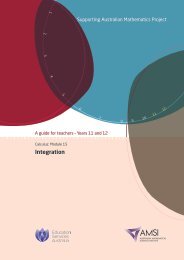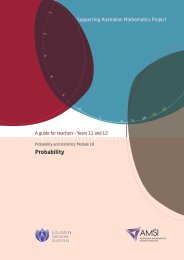Quadratics - the Australian Mathematical Sciences Institute
Quadratics - the Australian Mathematical Sciences Institute
Quadratics - the Australian Mathematical Sciences Institute
Create successful ePaper yourself
Turn your PDF publications into a flip-book with our unique Google optimized e-Paper software.
A guide for teachers – Years 11 and 12 • {25}<br />
Exercise 13<br />
Put <strong>the</strong> parabola y 2 − 2y = 4x − 5 into <strong>the</strong> above standard form (for a directrix parallel to<br />
<strong>the</strong> y-axis) and thus find its vertex, focus and directrix, and sketch its graph.<br />
Parametric equations of a parabola<br />
Since every parabola is congruent to x 2 = 4ay, for some choice of a > 0, we can study <strong>the</strong><br />
geometry of every parabola by confining ourselves to this one! This shows <strong>the</strong> power of<br />
both coordinate geometry and transformations.<br />
Imagine a particle moving in <strong>the</strong> plane along a curve C as shown.<br />
y<br />
P(x,y) = (f(t),g(t))<br />
0<br />
x<br />
The x- and y-coordinates of <strong>the</strong> particle can be thought of as functions of a new variable<br />
t, and so we can write x = f (t), y = g (t), where f , g are functions of t. In some<br />
physical problems t is thought of as time.<br />
The equations<br />
x = f (t)<br />
y = g (t)<br />
are called <strong>the</strong> parametric equations of <strong>the</strong> point P(x, y) and <strong>the</strong> variable t is called a<br />
parameter.<br />
It is often very useful to take a cartesian equation y = F (x) and introduce a parameter t<br />
so that <strong>the</strong> x- and y-coordinates of any point on <strong>the</strong> curve can be expressed in terms of<br />
this parameter.
















